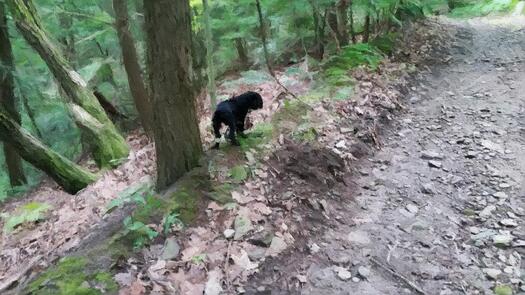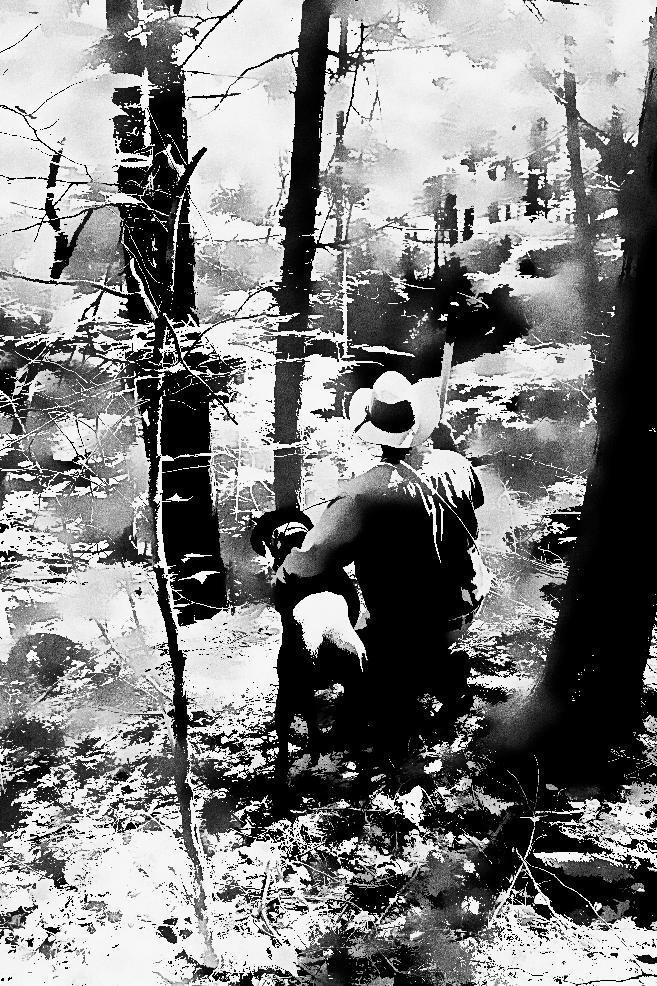 There had always been something different about him. Jacob Ernst had raised many coonhounds in his time, and this one, he told his son, Nathan, bore watching. When the pup’s littermates ventured from the whelping kennel for the first time, they clustered—staying close to one another and within a few feet of their ever-protective mother. But not him—this special pup with the shiny coat darker than a moonless night. That mid-spring day, the barely 3-week-old pup moved on his short, stubby legs another twenty yards beyond, exploring more of the barnyard. The next morning, his siblings had gained more courage to explore the world once Nathan had opened their pen. Now, they moved twenty yards from their familiar kennel. However, the ebony pup, alone, ventured closer to fifty yards away from his siblings. Nathan could see the pup had his nose to the ground, tracking something. Had the young coon hunter not seen a chicken cross the yard not five minutes before, Nathan might not have known this pup was already following a trail. Several weeks passed, but the routine remained the same. By this time, the other puppies were showing some independence, eager to run about the yard when Nathan came to feed them each morning. The young independent cur would warmly greet the young man, but immediately run about the yard, away from the others, searching for something to explore on his own. One sunny morning, after Nathan had finished feeding and watering their hounds, as well as cleaning the kennels, he began to round up the free-roaming puppies. After several minutes, he had them all back in their pen, except one. And the ebony pup was nowhere in sight. Nathan looked up to see his father on their home’s front porch steps. Jacob used his large hunting knife to whittle a stick. His father looked at him with a knowing smile. “The pup headed toward the woods and just went over the creek bank,” Jacob said, pointing with his knife. “That way. Best fetch him. No tellin' what sort of trouble that one might get into.” “I’ll get him, Pa.” The stream marked where their farm’s fields ended, and the forest began. While it was only a little over one hundred yards, the distance felt much longer as Nathan sprinted, knowing the youngling could easily become lost and leave no trail to follow. Further, these woodlands held several large predators—bear, coyote, and even a large raptor or two—that could easily harm the defenseless pup. As he hurdled the stream’s bank, Nathan’s fears evaporated. There in plain sight, beneath the limbs of large hemlocks with his small tail swinging excitedly back and forth, the pup stood with his nose to the ground, scenting something in the mud. “What have we here?” Nathan walked over to kneel beside the puppy, who now looked up at him, tail still wagging. Across Ryland Creek’s muddy bottom, dozens of raccoon tracks crisscrossed the area. “Very good, Seth. Someday, you’ll follow those to wherever they lead.” Nathan smiled, gently petting the pup’s head. The little ebony cur made eye contact upon hearing his name. The young man rose to his full height. “Well, you wanted to explore, did you? Ready for a hike?” Seth looked behind Nathan at the creek bank. Hidden beyond that small rise were his mother and siblings—all the pup’s familiarity with the world. The young hound placed his paw on the man’s boot while meeting his master’s stare and released a surprisingly loud bark for one so small. “Very well,” Nathan said. “Follow me.” He entered the ankle-deep water and began walking downstream. He’d gone several yards when he turned. The pup hadn’t moved, studying the creek’s wetness, hesitating. “Come now, Seth. There will be many creeks to cross in the years to come.” With several glances between the man and the slow flowing creek, the little hound’s body tensed, and then sprang into the water. Sloshing in the cool wetness, the pup soon regained his place by Nathan’s side. Together, they made their way downstream for another hundred yards. Here, the forested hills of Ryland Creek began to steepen into a ravine. After several minutes more, Nathan determined they had gone far enough. A quick loop back to the farm through the forest would be enough adventure for the young Seth. Erosion had undercut the creek banks. With some effort, Nathan put a knee on the waist-high bank and clambered over the side. He turned to study the young hound, knowing the young pup couldn’t negotiate the short but steep grade. Looking at the impassable obstacle, Seth whimpered. Many years later, Nathan would remember this moment. For Seth would make that defeated sound only this once and never again. “Figure it out. You can do this.” The pup retreated a few small steps into deeper water. Looking up and down the stream, Seth spied a deer trail leading to the creek. Splashing through the water, Seth came to the narrow path and quickly traversed it. The hound spun around and ran straight for the man. His man. “Atta boy! I knew you could do it.” Nathan cupped the hound’s small head in one hand. “Let’s head home.” The pair walked away from the creek and deeper into the forest, following an old trail. Often, Nathan checked behind to ensure the pup remained close. Each time he turned, there was Seth, not more than five yards behind. The grade steepened, but the intrepid pup didn’t complain and kept pace on his small legs. Nearing the final trail that would lead home, Nathan stopped. Before them stood a nearly vertical, rocky outcropping. There was no way the young pup could be expected to scale this climb on his own. “I’ll carry you up this one,” Nathan said, slowly turning to see . . . nothing. “Seth!” Nathan shouted, desperately searching the way he’d just come. “Seth!” he shouted again. A response came, in the form of a tiny roar. Behind him. Spinning about, Nathan found the young prince of hounds already atop the rocky outcropping. The small puppy again loosed another long bark, encouraging his master to join him now. The coon hunter laughed—in no small measure relieved—at seeing the pup safe and so close by. Nathan looked into the little ebony cur’s bold eyes. “You truly will become an exceptional hound.”
1 Comment
|
Categories
All
|
- Ryland Creek
- About The Ryland Creek Novels
- Buy the Ryland Creek Saga: Print Books
- Buy the Ryland Creek Saga in E-Book
- The Ryland Creek Saga in Audiobook
- Blog: In a place called Painted Post
- Reader Reviews for The Ryland Creek series
- Meet the Author:Joseph Gary Crance
- An Ode to Painted Post
- The Magical Realism of the Ryland Creek Saga
- Other local authors
- Contact
- Leave A Reader Review
- Ryland Creek
- About The Ryland Creek Novels
- Buy the Ryland Creek Saga: Print Books
- Buy the Ryland Creek Saga in E-Book
- The Ryland Creek Saga in Audiobook
- Blog: In a place called Painted Post
- Reader Reviews for The Ryland Creek series
- Meet the Author:Joseph Gary Crance
- An Ode to Painted Post
- The Magical Realism of the Ryland Creek Saga
- Other local authors
- Contact
- Leave A Reader Review

 RSS Feed
RSS Feed